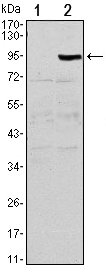Total OPG Cell-Based Colorimetric ELISA Kit
- Catalog No.:KA3441C
- Applications:ELISA
- Reactivity:Human;Mouse
- Gene Name:
- TNFRSF11B
- Human Gene Id:
- 4982
- Human Swiss Prot No:
- O00300
- Mouse Swiss Prot No:
- O08712
- Storage Stability:
- 2-8°C/6 months
- Other Name:
- Tumor necrosis factor receptor superfamily member 11B (Osteoclastogenesis inhibitory factor) (Osteoprotegerin)
- Detection Method:
- Colorimetric
- Background:
- disease:Defects in TNFRSF11B are the cause of juvenile Paget disease (JPD) [MIM:239000]; also called hyperostosis corticalis deformans juvenilis or hereditary hyperphosphatasia or chronic congenital idiopathic hyperphosphatasia. JPD is a rare autosomal recessive osteopathy that presents in infancy or early childhood. The disorder is characterized by rapidly remodeling woven bone, osteopenia, debilitating fractures, and deformities due to a markedly accelerated rate of bone remodeling throughout the skeleton. Approximately 40 cases of JPD have been reported worldwide. Unless it is treated with drugs that block osteoclast-mediated skeletal resorption, the disease can be fatal.,function:Acts as decoy receptor for RANKL and thereby neutralizes its function in osteoclastogenesis. Inhibits the activation of osteoclasts and promotes osteoclast apoptosis in vitro. Bone homeostasis seems to depend on the local RANKL/OPG ratio. May also play a role in preventing arterial calcification. May act as decoy receptor for TRAIL and protect against apoptosis. TRAIL binding blocks the inhibition of osteoclastogenesis.,induction:Up-regulated by increasing calcium-concentration in the medium and estrogens. Down-regulated by glucocorticoids.,PTM:N-glycosylated. Contains sialic acid residues.,PTM:The N-terminus is blocked.,similarity:Contains 2 death domains.,similarity:Contains 4 TNFR-Cys repeats.,subunit:Homodimer.,tissue specificity:Highly expressed in adult lung, heart, kidney, liver, spleen, thymus, prostate, ovary, small intestine, thyroid, lymph node, trachea, adrenal gland, testis, and bone marrow. Detected at very low levels in brain, placenta and skeletal muscle. Highly expressed in fetal kidney, liver and lung.,
- Function:
- skeletal system development, apoptosis, response to nutrient, cell death, response to endogenous stimulus,response to hormone stimulus, response to extracellular stimulus, response to organic substance, response to inorganic substance, response to metal ion, programmed cell death, death, extracellular matrix organization, response to nutrient levels, response to magnesium ion, regulation of homeostatic process, negative regulation of homeostatic process, regulation of tissue remodeling, negative regulation of tissue remodeling, regulation of odontogenesis,negative regulation of odontogenesis, regulation of odontogenesis of dentine-containing tooth, negative regulation of odontogenesis of dentine-containing tooth, response to drug, extracellular structure organization, response to estrogen stimulus, regulation of bone resorption, negative regulation of bone resorption, response to arsenic
- Subcellular Location:
- Secreted.
- Expression:
- Highly expressed in adult lung, heart, kidney, liver, spleen, thymus, prostate, ovary, small intestine, thyroid, lymph node, trachea, adrenal gland, testis, and bone marrow. Detected at very low levels in brain, placenta and skeletal muscle. Highly expressed in fetal kidney, liver and lung.
- June 19-2018
- WESTERN IMMUNOBLOTTING PROTOCOL
- June 19-2018
- IMMUNOHISTOCHEMISTRY-PARAFFIN PROTOCOL
- June 19-2018
- IMMUNOFLUORESCENCE PROTOCOL
- September 08-2020
- FLOW-CYTOMEYRT-PROTOCOL
- May 20-2022
- Cell-Based ELISA│解您多样本WB检测之困扰
- July 13-2018
- CELL-BASED-ELISA-PROTOCOL-FOR-ACETYL-PROTEIN
- July 13-2018
- CELL-BASED-ELISA-PROTOCOL-FOR-PHOSPHO-PROTEIN
- July 13-2018
- Antibody-FAQs



